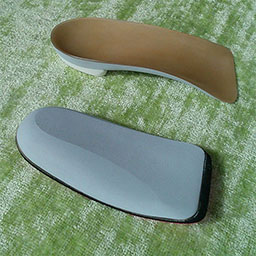We all know someone who has orthotics.
Some of us may know childhood friends who got orthotics and maybe you even tried to slip your foot in their shoe to feel how ‘their foot feels’ like you might put on someone’s glasses to ‘see how blind they are’.
But how do you if you need orthotics or not? What foot problems require them? We’ve got you covered!
Watch this week’s 2 minute tip where Dr. Rob gives you the low down on orthotics!
https://youtu.be/ffnDNC6jQaU
Let’s start with what orthotics are and how they’re different from inserts.

- Inserts that you can buy in stores without a prescription can provide cushioning and support for your feet. They’re made of stuff like gel, plastic, or foam and can usually be trimmed or fit into any type of shoe.
Inserts are meant to make your shoes more comfortable but are not designed to correct foot problems.

- Orthotics are prescription medical devices that you wear inside your shoes that may correct biomechanical foot issues such as problems with how you walk, stand, or run.
They are custom made for your feet and help correct foot posture to improve your gait if you have a problem
Some of the common issues that orthotics may help include:
- Flat Feet
- High Arches
- Plantar Fasciitis – inflammation of the sole of the foot causing pain, usually first thing in the morning
- Arthritis – it can often affect the joints of the feet
- Diabetes – certain orthotics may help circulation by modifying the person’s shoes.
- Heel spurs. Heel spurs are conditions where excess bone grows on the back or bottom of the heel. Orthotics can support the foot and reduce inflammation.
Aching feet? How about aching knees or hips?
Orthotics are not always prescribed for foot pain. Sometimes the source of pain up your leg could be coming from your feet!
When your ankle collapses inward or pronates, it affects the knee causing it to turn inward and to compensate, your hip now has to turn in too!

Everything in your body is connected, so it makes sense that problems in one area can affect others.
Now orthotics may not be the magical fix for your hip, foot, or knee issue. Like Dr. Rob said in the video, a lot of patients need a few sessions of hands on therapy and some exercises to help correct their issue but, for some people, orthotics may be the solution!
Try Dr. Rob’s at home Single Leg Test to reveal a ton about your lower leg mechanics!
Stand in front of a mirror and stand on one leg. If you need to hold on to something for balance try bringing a chair over to the mirror for stability. Bend the knee you’re standing on to go into a one legged squat and watch your knee.
If your knee goes in it may mean that you have collapsing arches and are over-pronating.
If your knee goes out you may have high and rigid arches and are under-pronating.
We here at PRICE have only recently started offering orthotics. We use super cool 3D scanning to make a 3D mold of your foot which is then used to make flexible foam orthotics. None of those super rigid and uncomfortable orthotics you’ve seen before!
Think you may benefit from orthotics? Come in and get assessed by one of our great chiropractors! They’ll be able to get to the bottom of your issue and recommend the proper treatment. Whether that’s orthotics, manual therapy, or exercises.
